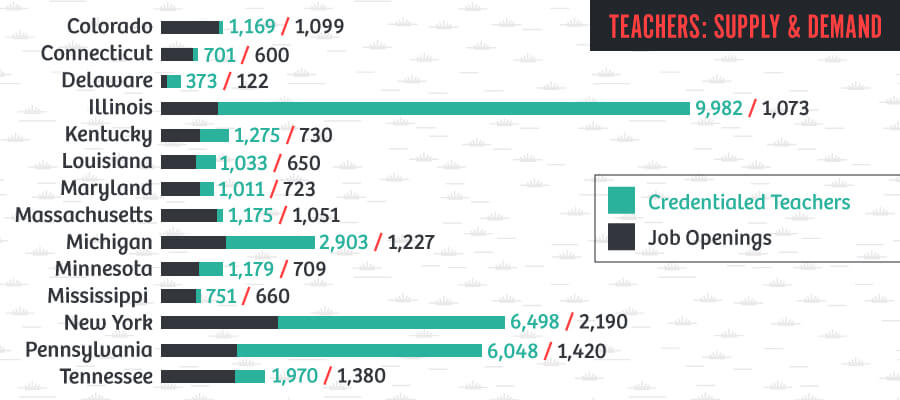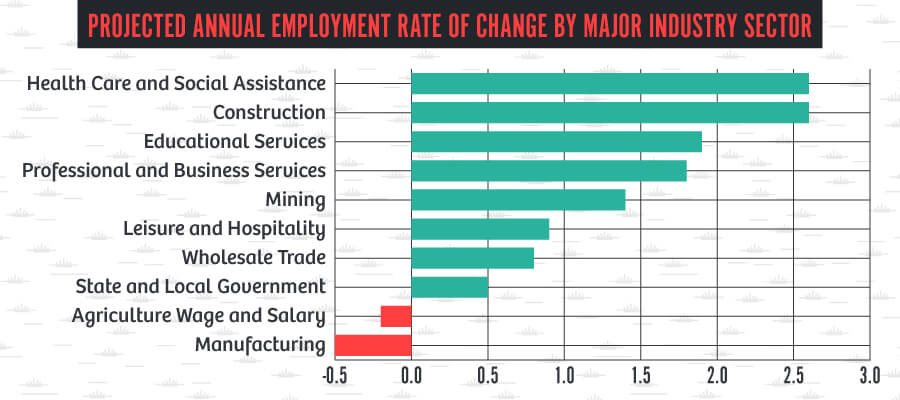The demand for teachers is real. The need for teachers is universal, regardless of economic conditions and political climates. However, the problem of teacher shortages in the United States isn’t so black and white. The problem starts with the fact that the shortage isn’t present in all areas of teaching. Although the teacher employment picture varies from region to region, overall, many states are being flooded with elementary school teachers while facing an increasing shortage of teachers in content specific areas like math, science, and special education. Several states have seen alarming drops in enrollment in teacher preparation programs. However, this teacher imbalance has also been attributed to a lack of high-quality teacher training programs and an increasing preponderance of comparatively low-quality preparation programs. Nonetheless, strengthening teacher preparation is at peak necessity. With the wave of baby boomer teacher retirements upon us, novice teachers contribute to the highest percentage of the teacher workforce ever. Improving teacher preparation as well as what kinds of teachers are introduced into the market will be necessary goals in rebalancing teacher supply-and-demand.
Teacher Shortages and Surpluses
According to data from the National Council on Teacher Quality, the United States is producing double the amount of K-5 elementary school teachers needed each year while the shortage of teachers exists in content specific areas such as math, science, and special education. The National Center for Education Statistics reported that there were 1,708,057 elementary school teachers as of 2010, the most recent year for which statistics are available. However, the Bureau of Labor Statistics has reported that there were1,519,700 jobs for kindergarten and elementary school teachers in the United States as of 2012.
Although this discrepancy is not overwhelming, imbalances at the state level are more telling. Short term

Many analysts of the education market have deduced that elementary teachers are flooding the market because universities and colleges do not make any effort to match supply and demand as other professions might do. An article by Education Week states that, in contrast to other countries, the United States does not provide “management of access to particular majors in higher education, tied to perceived needs of teachers, and also a national system for getting teachers who have graduated to the hard-to-staff places.” The article points to Maryland teacher employment statistics as an illustration of this point. The data states that although there are teacher shortages in more than a dozen fields, the state itself produces almost enough elementary teachers to fill its districts’ vacancies. The Maryland Teacher Staffing Report 2012-2014 does show that with 1,000 teachers certified from 2010 to 2011, almost 1,100 were hired. However, according to the report, staffing needs for certification areas are critical for more than a dozen areas including mathematics, science (chemistry, physics, etc.), ESOL, and special education. What these surpluses are showing us is that although there are a lot of teachers out there, they are oversubscribing to a certain area of teaching that does not actually have a shortage.
Improving Teacher Quality
The question then becomes: why should policymakers be concerned with teacher supply-and-demand mismatches? The NCTQ in an article has argued that by producing fewer elementary school teachers, colleges could be more selective about admittance and give candidates a more intensive experience, including a full year of student-teaching that national organizations for teacher-college accreditation have endorsed. What the NCTQ of course is endorsing is improving teacher preparation and, subsequently, teacher quality, thus producing better qualified graduates who are prepared to fill the voids that actually exist in the United States teaching market. An Educational Testing Service Report from 2007 did find that, although the academic profile for teachers has improved, elementary school teachers continue to have–in general– lower qualifications than other college graduates.
A major study funded by the Center on International Education Benchmarking determined a similar solution as the NCTQ to managing supply and demand for educators by surveying four of the top performing education systems, Shanghai, Singapore, Ontario, and Finland, and comparing those teacher quality systems against the United States. The study concluded that there were four indicators that helped to ensure balanced supply and demand of high quality teachers: (1) monitoring supply and demand to try and avoid surpluses or deficits of teachers, (2) setting competitive requirements for entry into preparation programs to attract academically qualified candidates, (3) offering teacher preparation at high-status research universities that blend theory, practice, and in-depth mastery of content aligned to core curriculum, and (4) controlling for the quality of preparation by limiting the number of institutions authorized to prepare teachers.
According to the study, the main difference between the United States teacher preparation programs and top performing countries educationally is the sheer number of teacher preparation programs included in community colleges, universities, and alternative certificate programs. The number of students in Massachusetts, the top performing state educationally, is 953,000, while it trains just over 4,000 teachers per year, a normal number of students and student to teacher ratio in comparison to other top performing education systems (Singapore having 522,000 students and training about 2,000 teachers per year and Ontario having about 2 million students and training almost 9,000 teachers per year). However, the other four education systems all have below 20 training programs that are highly intensive and highly competitive, Ontario having the most at 17 and Singapore having only 1 teacher training program. In contrast, in the United States teacher education programs are actually not able to fill all of their spaces and are thus allowing admissions with low qualifications. The United States also has no means of monitoring or controlling supply and demand of teachers and what they are trained in. Finland and Singapore have produced studies on teacher supply and demand annually and biannually-respectively -allowing them to adjust available slots. Creating a more rigorous teacher selection also allows for higher retention rates. In the United States we lose almost half of our teachers every 5 years and thus we have to continue training novice teachers who become unqualified to teach in areas that are in critical need in the market.

Drops in Teacher Prep Enrollment
However, even with the United States having a lowered standard for qualifications for entrance into teacher preparation programs, programs are still struggling to fill spaces, with steep drops in enrollment being seen in the past few years. According to U.S. Department of Education Title II statistics, enrollments in university teacher prep programs have fallen almost 10 percent from 2004 to 2012. According to an NPR article, some of the nation’s largest producers of educators such as California, New York, and Texas have seen steep drops in enrollment. California in particular has taken a huge hit, losing almost 53 percent of its enrollment over the past five years. In North Carolina, enrollment has decreased 20 percent in the past three years.

The reasons for these drops are not entirely clear. However many have postulated a few reasons as to why potential teachers are suddenly fleeing from the profession. The earlier referenced NPR article quoted the dean of the University of North Carolina School of Education as postulating that the strengthening of the U.S. economy and the “erosion of teaching’s image as a stable career” has perpetuated an image that K-12 teachers are having less and less control over their profession as a result of increased politicization. The article references a multitude of reasons for such erosions of stability including recession-induced budget cuts, dissipation of tenure protection, and ideological disagreements over Common Core State Standards, which brings along with it highly pressurized testing that directly relates to teacher evaluations. The profession is also given a lot of flak for being the “root of the problem” when it comes to problems in the realm of education. In short: if everyone gets together and blames the teachers for the misguided decisions of lawmakers and politicians, then teachers aren’t going to want to teach.
Thus, what we see here is not only a problem with mismatches in teacher supply and demand and lackluster teacher preparation programs to fill necessary holes in the education market, but a highly politicized profession that is simply overwhelmed. Even alternative teacher certification programs such as Teach for America are seeing dips in enrollment in the past two years, according to an article in the New York Times. One of the alternative solutions to the fleeing of teachers is to pay them more. However, across the country, proposals to boost pay or give teachers merit pay have either been stopped dead in their tracks or have been completely rejected altogether.
Future Prospects for Growth in the Education Profession
Although many do recognize that teachers should be paid more and that the profession needs to take more time to make sure quality teachers are fulfilling the needs of the districts in which they teach, many teachers still make a fairly comfortable salary depending on the Cost of Living Index of where they teach. For example in Michigan, the teacher’s average salary is $61,560, which adjusted for how far dollars go, is more like $64,937. Michigan spends about 30 percent of all of its education expenditures on teachers’ salaries. In Pennsylvania, even after experiencing a 4 percent drop from 2000 to 2013, a teacher shortage, and two teacher strikes in 2012 affecting 600 public school educations in various districts, teachers still earn an average of $63,521 yearly.
Furthermore, the job outlook for the education careers is still high even with the obstacles that it currently faces. The Bureau of Labor Statistics states that new jobs for kindergarten and elementary teachers will grow by 17 percent from 2010 to 2020, with much of this growth being attributed to reducing student-teacher ratios and increasing enrollment. The South and the West will be the beneficiaries of this growth, while the Northeast will probably see a decline in new jobs for kindergarten and elementary teachers. A similar percentage growth by 2020 is also expected for middle school teachers, from grades six through eight. These new job opportunities will most likely arise from the retirement of older teachers. Furthermore, as has been stated, employment opportunities for educators in special education or ESOL will definitely have increased employment opportunities. The major conclusion is that even with the challenges ahead, the education sector as an industry is moving forward positively.

While overall growth in the education sector is strong, imbalances in supply and demand bring a few core objectives into the spotlight: we need to focus on retaining quality teachers in areas in which they are needed, by pay or political change. . A study by the Edunomics Lab projects a way forward that would yield higher pay without fiscal sacrifice: “increasing the class sizes of only the most effective teachers.” Targeted increases in such class sizes would allow for fewer teachers in total and the savings from reducing the number of teachers could be reattributed to creating bonuses for teachers. This is one method for increasing the quality of teachers, filling the open opportunities that jobs prospects seem to be saying will be increasing, and creating for a more stable teaching profession. Although this solution comes from a reduction in the overall teaching force, which angers teachers unions and allies, it will still push forward many of the successful theories and systems that other countries have used by reducing the influx of unqualified teachers and injecting into the market teachers that are more readily qualified to enact change in the educational system.